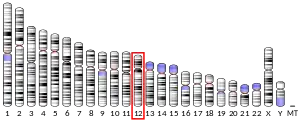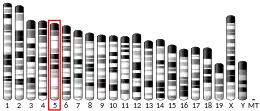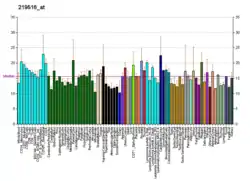Transient receptor potential cation channel subfamily V member 4 is an ion channel protein that in humans is encoded by the TRPV4 gene.
The TRPV4 gene encodes TRPV4, initially named "vanilloid-receptor related osmotically activated channel" (VR-OAC) and "OSM9-like transient receptor potential channel, member 4 (OTRPC4)",[5][6] a member of the vanilloid subfamily in the transient receptor potential (TRP) superfamily of ion channels.[7][8][9] The encoded protein is a Ca2+-permeable, nonselective cation channel that has been found involved in multiple physiologic functions, dysfunctions and also disease. It functions in the regulation of systemic osmotic pressure by the brain, in vascular function, in liver, intestinal, renal and bladder function, in skin barrier function and response of the skin to ultraviolet-B radiation, in growth and structural integrity of the skeleton, in function of joints, in airway- and lung function, in retinal and inner ear function, and in pain. The channel is activated by osmotic, mechanical and chemical cues. It also responds to thermal changes (warmth). Channel activation can be sensitized by inflammation and injury.
The TRPV4 gene has been co-discovered by W. Liedtke et al.[5] and R. Strotmann et al.[6]
Clinical significance
Channelopathy mutations in the TRPV4 gene lead to skeletal dysplasias, premature osteoarthritis, and neurological motor function disorders and are associated with a range of disorders, including brachyolmia type 3, congenital distal spinal muscular atrophy, Familial digital arthropathy-brachydactyly (FDAB),[10] scapuloperoneal spinal muscular atrophy, and subtype 2C of Charcot–Marie–Tooth disease.[11]
Pharmacology
A number of TRPV4 agonists and antagonists have been identified since its discovery.[12] The discovery of unselective modulators (e.g. antagonist Ruthenium red) was followed by the apparition of more potent (agonist 4aPDD)[13] or selective (antagonist RN-1734)[14] compounds, including some with bioavailability suitable for in vivo pharmacology studies such as agonist GSK1016790A[15] (with ~10 fold selectivity vs TRPV1), and antagonists HC-067047[16] (with ~5 fold selectivity vs hERG and ~10 fold selectivity vs TRPM8) and RN-9893[17] (with ~50 fold selectivity vs TRPM8 and ~10 fold selectivity vs M1).
Resolvin D1 (RvD1), a metabolite of the omega 3 fatty acid, docosahexaenoic acid, is a member of the specialized proresolving mediators (SPMs) class of metabolites that function to resolve diverse inflammatory reactions and diseases in animal models and, it is proposed, humans. This SPM also dampens pain perception arising from various inflammation-based causes in animal models. The mechanism behind this pain-dampening effect involves the inhibition of TRPV4, probably (in at least certain cases) by an indirect effect wherein it activates another receptor located on neurons or nearby microglia or astrocytes. CMKLR1, GPR32, FPR2, and NMDA receptors have been proposed to be the receptors through which a SPM may operate to down-regulate TRPs and thereby pain perception.[18][19][20][21][22]
Interactions
Implication in Temperature-Dependent Sex Determination in Reptiles
TRPV4 has been proposed to be the thermal sensor in gonads of Alligator mississipiensis, a species with temperature-dependent sex determination.[25] However the data were over interpreted and TRPV4 is probably not involved in temperature-dependent sex determination due to large overlap of expression at male producing temperature and female producing temperature for example.
See also
References
- 1 2 3 GRCh38: Ensembl release 89: ENSG00000111199 - Ensembl, May 2017
- 1 2 3 GRCm38: Ensembl release 89: ENSMUSG00000014158 - Ensembl, May 2017
- ↑ "Human PubMed Reference:". National Center for Biotechnology Information, U.S. National Library of Medicine.
- ↑ "Mouse PubMed Reference:". National Center for Biotechnology Information, U.S. National Library of Medicine.
- 1 2 Liedtke W, Choe Y, Martí-Renom MA, Bell AM, Denis CS, Sali A, et al. (October 2000). "Vanilloid receptor-related osmotically activated channel (VR-OAC), a candidate vertebrate osmoreceptor". Cell. 103 (3): 525–535. doi:10.1016/S0092-8674(00)00143-4. PMC 2211528. PMID 11081638.
- 1 2 Strotmann R, Harteneck C, Nunnenmacher K, Schultz G, Plant TD (October 2000). "OTRPC4, a nonselective cation channel that confers sensitivity to extracellular osmolarity". Nature Cell Biology. 2 (10): 695–702. doi:10.1038/35036318. PMID 11025659. S2CID 21148080.
- ↑ Clapham DE, Julius D, Montell C, Schultz G (December 2005). "International Union of Pharmacology. XLIX. Nomenclature and structure-function relationships of transient receptor potential channels". Pharmacological Reviews. 57 (4): 427–450. doi:10.1124/pr.57.4.6. PMID 16382100. S2CID 17936350.
- ↑ Harteneck C, Plant TD, Schultz G (April 2000). "From worm to man: three subfamilies of TRP channels". Trends in Neurosciences. 23 (4): 159–166. doi:10.1016/S0166-2236(99)01532-5. PMID 10717675. S2CID 41074873.
- ↑ Plant TD, Strotmann R (2007). "TRPV4". Transient Receptor Potential (TRP) Channels. Handbook of Experimental Pharmacology. Vol. 179. pp. 189–205. doi:10.1007/978-3-540-34891-7_11. ISBN 978-3-540-34889-4. PMID 17217058.
- ↑ Lamandé SR, Yuan Y, Gresshoff IL, Rowley L, Belluoccio D, Kaluarachchi K, et al. (October 2011). "Mutations in TRPV4 cause an inherited arthropathy of hands and feet". Nature Genetics. 43 (11): 1142–1146. doi:10.1038/ng.945. PMID 21964574. S2CID 27430401.
- ↑ Online Mendelian Inheritance in Man (OMIM): 605427
- ↑ Vincent F, Duncton MA (2011). "TRPV4 agonists and antagonists". Current Topics in Medicinal Chemistry. 11 (17): 2216–2226. doi:10.2174/156802611796904861. PMID 21671873.
- ↑ Watanabe H, Davis JB, Smart D, Jerman JC, Smith GD, Hayes P, et al. (April 2002). "Activation of TRPV4 channels (hVRL-2/mTRP12) by phorbol derivatives". The Journal of Biological Chemistry. 277 (16): 13569–13577. doi:10.1074/jbc.M200062200. PMID 11827975.
- ↑ Vincent F, Acevedo A, Nguyen MT, Dourado M, DeFalco J, Gustafson A, et al. (November 2009). "Identification and characterization of novel TRPV4 modulators". Biochemical and Biophysical Research Communications. 389 (3): 490–494. doi:10.1016/j.bbrc.2009.09.007. PMID 19737537.
- ↑ Thorneloe KS, Sulpizio AC, Lin Z, Figueroa DJ, Clouse AK, McCafferty GP, et al. (August 2008). "N-((1S)-1-{[4-((2S)-2-{[(2,4-dichlorophenyl)sulfonyl]amino}-3-hydroxypropanoyl)-1-piperazinyl]carbonyl}-3-methylbutyl)-1-benzothiophene-2-carboxamide (GSK1016790A), a novel and potent transient receptor potential vanilloid 4 channel agonist induces urinary bladder contraction and hyperactivity: Part I". The Journal of Pharmacology and Experimental Therapeutics. 326 (2): 432–442. doi:10.1124/jpet.108.139295. PMID 18499743. S2CID 517735.
- ↑ Everaerts W, Zhen X, Ghosh D, Vriens J, Gevaert T, Gilbert JP, et al. (November 2010). "Inhibition of the cation channel TRPV4 improves bladder function in mice and rats with cyclophosphamide-induced cystitis". Proceedings of the National Academy of Sciences of the United States of America. 107 (44): 19084–19089. Bibcode:2010PNAS..10719084E. doi:10.1073/pnas.1005333107. PMC 2973867. PMID 20956320.
- ↑ Wei ZL, Nguyen MT, O'Mahony DJ, Acevedo A, Zipfel S, Zhang Q, et al. (September 2015). "Identification of orally-bioavailable antagonists of the TRPV4 ion-channel". Bioorganic & Medicinal Chemistry Letters. 25 (18): 4011–4015. doi:10.1016/j.bmcl.2015.06.098. PMID 26235950.
- ↑ Qu Q, Xuan W, Fan GH (January 2015). "Roles of resolvins in the resolution of acute inflammation". Cell Biology International. 39 (1): 3–22. doi:10.1002/cbin.10345. PMID 25052386. S2CID 10160642.
- ↑ Serhan CN, Chiang N, Dalli J, Levy BD (October 2014). "Lipid mediators in the resolution of inflammation". Cold Spring Harbor Perspectives in Biology. 7 (2): a016311. doi:10.1101/cshperspect.a016311. PMC 4315926. PMID 25359497.
- ↑ Lim JY, Park CK, Hwang SW (2015). "Biological Roles of Resolvins and Related Substances in the Resolution of Pain". BioMed Research International. 2015: 830930. doi:10.1155/2015/830930. PMC 4538417. PMID 26339646.
- ↑ Ji RR, Xu ZZ, Strichartz G, Serhan CN (November 2011). "Emerging roles of resolvins in the resolution of inflammation and pain". Trends in Neurosciences. 34 (11): 599–609. doi:10.1016/j.tins.2011.08.005. PMC 3200462. PMID 21963090.
- ↑ Serhan CN, Chiang N, Dalli J (May 2015). "The resolution code of acute inflammation: Novel pro-resolving lipid mediators in resolution". Seminars in Immunology. 27 (3): 200–215. doi:10.1016/j.smim.2015.03.004. PMC 4515371. PMID 25857211.
- ↑ Suzuki M, Hirao A, Mizuno A (December 2003). "Microtubule-associated [corrected] protein 7 increases the membrane expression of transient receptor potential vanilloid 4 (TRPV4)". The Journal of Biological Chemistry. 278 (51): 51448–51453. doi:10.1074/jbc.M308212200. PMID 14517216.
- ↑ Xu H, Zhao H, Tian W, Yoshida K, Roullet JB, Cohen DM (March 2003). "Regulation of a transient receptor potential (TRP) channel by tyrosine phosphorylation. SRC family kinase-dependent tyrosine phosphorylation of TRPV4 on TYR-253 mediates its response to hypotonic stress". The Journal of Biological Chemistry. 278 (13): 11520–11527. doi:10.1074/jbc.M211061200. PMID 12538589.
- ↑ Yatsu R, Miyagawa S, Kohno S, Saito S, Lowers RH, Ogino Y, Fukuta N, Katsu Y, Ohta Y, Tominaga M, Guillette LJ, Iguchi T (2015). "TRPV4 associates environmental temperature and sex determination in the American alligator". Sci Rep. 5: 18581. doi:10.1038/srep18581. PMC 4683465. PMID 26677944.
External links
- GeneReviews/NCBI/NIH/UW entry on Charcot-Marie-Tooth Neuropathy Type 2
- TRPV4+protein,+human at the U.S. National Library of Medicine Medical Subject Headings (MeSH)
This article incorporates text from the United States National Library of Medicine, which is in the public domain.




